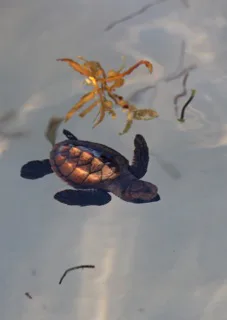Hawksbill Sea Turtle Hatchlings Found on South Caicos
During a recent Sunday beach walk here in South Caicos, we came across 15 hawksbill turtle (Eretmochelys imbricata) hatchlings floating in the shallows. Although an undeniably cute and lucky encounter for us, it unfortunately suggests something may have gone wrong with their first day into the world outside of their eggs. After a few days of intense heat here with no breeze, the shallows were as hot as bath water, and contrary to the active behavior that hatchlings should show, these turtles were lethargically drifting and flipping in the small ripples hitting the beach. If all had gone to plan, these turtles would have crawled out of the sand during the night and rushed to the sea, swimming quickly into deeper water to minimise the chance of predation both on land and in the shallows.

Upon finding the floating hatchlings, we searched the beach for the nest to see if any were still emerging, but found no evidence of a nest nearby. However, two days later we returned to search a beach further along the coast, and before long saw a conspicuous depression in the sand near some scattered shell fragments. After a few minutes digging we revealed the nest with ~107 empty shells buried in a depth of about 70cm. It cannot be discounted that local predators may have preyed on any struggling turtles, however, given there are few large animals on this island of scrub and sand dune habitat save for dogs and donkeys, it is likely the nest had a 100% hatch success, with no turtle remains found amongst the egg shells in the nest.
Hawksbill populations are heavily depleted worldwide. Hopefully many of those 107 hatchlings were triumphant in their voyage to the open ocean, and will be lucky enough to grow to adulthood by escaping the many dangers they face out in the blue (from barracudas and sharks to island fishermen). Surviving females will return to this very same beach in ~15-40 years to give birth themselves, guided by the visual, magnetic, and kinetic cues they recorded on that very first night when they made their dash for the ocean.

If you happen to find turtle hatchlings struggling in the shallows, the best thing to do would be to collect the hatchlings and place them in a bucket and cover them with sand. This will relax them, stop them frantically moving and save their energy for release, which should be done at night to reduce predation from fish, etc. Unfortunately there is little else we can do for them without a more sophisticated hatchery program in place. Nurturing young turtles should not be undertaken lightly, as it takes a lot of time, energy and resources, and one would need to look after them for at least 2 years before they will be ready for release into the wild. As hatchlings their mortality rate is very high, however by re-releasing them at night we can give them a fighting chance!
Our findings (number of hatchlings, nest location, and pictures) have been reported to the Turks & Caicos Islands Turtle Project of the Marine Conservation Society and the Department of the Environment and Maritime Affairs of the TCI. At the Center for Marine Resource Studies, we continue to monitor our nearby beaches regularly, to keep an eye out for any future nesting that occurs and collect data on these beautiful and important marine reptiles.
Photos courtesy of Kat Millage & Sophia Wassermann.
Related Posts


Alumni Reflections: Stories of the Return to Kenya
